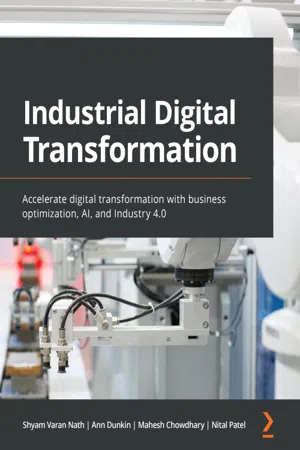
Industrial Digital Transformation
- 426 pages
- English
- ePUB (mobile friendly)
- Available on iOS & Android
Industrial Digital Transformation
About this book
Delve into industrial digital transformation and learn how to implement modern business strategies powered by digital technologies as well as organization and cultural optimizationKey Features• Identify potential industry disruptors from various business domains and emerging technologies• Leverage existing resources to identify new avenues for generating digital revenue• Boost digital transformation with cloud computing, big data, artificial intelligence (AI), and the Internet of Things (IoT)Book DescriptionDigital transformation requires the ability to identify opportunities across industries and apply the right technologies and tools to achieve results. This book is divided into two parts with the first covering what digital transformation is and why it is important. The second part focuses on how digital transformation works. After an introduction to digital transformation, you will explore the transformation journey in logical steps and understand how to build business cases and create productivity benefit statements. Next, you'll delve into advanced topics relating to overcoming various challenges. Later, the book will take you through case studies in both private and public sector organizations. You'll explore private sector organizations such as industrial and hi-tech manufacturing in detail and get to grips with public sector organizations by learning how transformation can be achieved on a global scale and how the resident experience can be improved. In addition to this, you will understand the role of artificial intelligence, machine learning and deep learning in digital transformation. Finally, you'll discover how to create a playbook that can ensure success in digital transformation. By the end of this book, you'll be well-versed with industrial digital transformation and be able to apply your skills in the real world.What you will learn• Get up to speed with digital transformation and its important aspects• Explore the skills that are needed to execute the transformation• Focus on the concepts of Digital Thread and Digital Twin• Understand how to leverage the ecosystem for successful transformation• Get to grips with various case studies spanning industries in both private and public sectors• Discover how to execute transformation at a global scale• Find out how AI delivers value in the transformation journeyWho this book is forThis book is for IT leaders, digital strategy leaders, line-of-business leaders, solution architects, and IT business partners looking for digital transformation opportunities within their organizations. Professionals from service and management consulting firms will also find this book useful. Basic knowledge of enterprise IT and some intermediate knowledge of identifying digital revenue streams or internal transformation opportunities are required to get started with this book.
Frequently asked questions
- Essential is ideal for learners and professionals who enjoy exploring a wide range of subjects. Access the Essential Library with 800,000+ trusted titles and best-sellers across business, personal growth, and the humanities. Includes unlimited reading time and Standard Read Aloud voice.
- Complete: Perfect for advanced learners and researchers needing full, unrestricted access. Unlock 1.4M+ books across hundreds of subjects, including academic and specialized titles. The Complete Plan also includes advanced features like Premium Read Aloud and Research Assistant.
Please note we cannot support devices running on iOS 13 and Android 7 or earlier. Learn more about using the app.
Information
Section 1: The "Why" of Digital Transformation
- Chapter 1, Introducing Digital Transformation
- Chapter 2, Transforming the Culture in an Organization
- Chapter 3, Accelerating Digital Transformation with Emerging Technologies
- Chapter 4, Industrial Digital Transformation
Chapter 1: Introducing Digital Transformation
- Exploring industrial digital transformation
- Identifying the business drivers for industrial digital transformation
- The evolution of industrial transformation
- The impact of industrial digital transformation on business
- Quantifying business outcomes and shareholder value
- The phases of the digital transformation journey
Exploring industrial digital transformation

Identifying the business drivers for industrial digital transformation

Business drivers in the commercial sector
- Defensive strategy
- Offensive strategy
Table of contents
- Industrial Digital Transformation
- Why subscribe?
- Preface
- Section 1: The "Why" of Digital Transformation
- Chapter 1: Introducing Digital Transformation
- Chapter 2: Transforming the Culture in an Organization
- Chapter 3: Emerging Technologies to Accelerate Digital Transformation
- Chapter 4: Business Drivers for Industrial Digital Transformation
- Section 2: The "How" of Digital Transformation
- Chapter 5: Transforming One Industry at a Time
- Chapter 6: Transforming the Public Sector
- Chapter 7: The Transformation Ecosystem
- Chapter 8: Artificial Intelligence in Digital Transformation
- Chapter 9: Pitfalls to Avoid in the Digital Transformation Journey
- Chapter 10: Measuring the Value of Transformation
- Chapter 11: The Blueprint for Success
- Other Books You May Enjoy